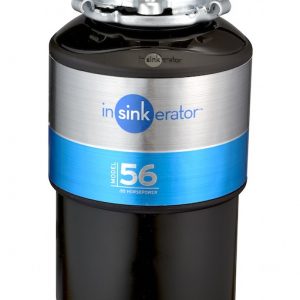Are there things you should not be putting down your InSinkErator?
One of the most useful kitchen appliances in our homes is the InSinkErator – also known as the food waste disposer, the waste disposal unit, the sink disposal unit. It’s a must-have for most of us as we’re now much more aware of different ways to reduce the amount of waste we’re putting into landfill. If you’re not able to compost your food scraps, a kitchen sink waste disposal unit is a great way to deal with some of your kitchen waste.
In order for your InSinkErator to work properly, however, you need to use it correctly. This starts with knowing what you should and should not be putting down the waste disposal unit.
What you can put down your waste disposal unit?
According to InSinkErator themselves, makers of the most popular waste disposal unit, you can put the following types of food waste down the grinder:
- vegetables
- fruit
- egg shells
- bones from fish and poultry
- meat, fish scraps
How to use your waste disposer properly?
The best way to flush these items down correctly and safely is to follow the helpful instructions provided by InSinkErator:
- Collect all food waste in the sink during food preparation and when scraping your dishes.
- Turn on the cold water first, then the food waste disposer.
- Feed the food waste into the food waste disposal unit. Listen for the food waste disposer to finish its work.
- After grinding is complete, turn off the food waste disposer and let the water run for a few seconds to flush the drain lines.
What you should keep out of your InSinkErator?
Waste disposers are meant to be used for food waste only (not any type of kitchen waste). The following list highlights common items that should stay out of the sink disposal unit:
- fibrous vegetables (e.g. celery)
- grease, oil, animal fat
- plastic
- paper
- glass
- metal
- cigarette butts
- packaging materials
- stickers from fruit and vegetables
- tea bag strings
It might seem obvious that some of these things shouldn’t be put down the sink, but at Regency Plumbing we’ve seen it all over our more than two decades of serving Auckland with all types of plumbing needs. Usually these items accidentally find their way into the drain, so we ask you to be extra diligent when putting dishes in the sink or washing up while cooking.
Other ways to keep your InSinkErator working properly
To get the most out of your waste disposal unit, we suggest you maintain and repair it when needed. We don’t recommend you try to fix your InSinkErator yourself. Doing so can be extremely dangerous and may also cancel out the warranty. Instead, give Regency Plumbing a call if you suspect your waste disposer is not working properly, or if you detect any strange sounds or leaks.
We also recommend that you clean your InSinkErator regularly. There are a few easy ways to clean your waste disposal unit:
- The easiest thing to do is to run it with just soapy water flushing down. We’re mindful of not using excessive amounts of water, but it is important in the long run to flush soapy water down to keep your waste disposer functioning efficiently. If it’s not working properly, it will actually use more water than necessary if you’re running it longer than you need to be because it’s not working as it should.
- Another way to clean it is to run vinegar ice cubes down while the InSinkErator is running. Simply fill a third of an ice cube tray with white vinegar (it’s very inexpensive) and freeze. When they’re frozen, run them down the waste disposer with cold water.
- You should avoid using harsh chemicals in your InSinkErator, but baking soda is another way to clean it. Just drop about a tablespoon of baking soda down the drain and flush down with cold water while the waste disposer is running.
- Whenever you use fresh lemon, put the lemon segments down the drain with the InSinkErator on. Grinding the lemon will help clean the unit, as well as deodorise it, eliminating any smells coming from the drain.
Have a look at our other post about “How long should an InSinkErator or waste disposal unit last?”.
Check out our waste disposal specials page here for great pricing on waste disposal units and installation.





